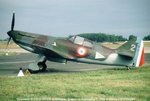delcyros
Tech Sergeant
The 110 is really not that bad. It succesfully participated in the escort, fighter, interceptor (Battle over the German Bay), recon and ground attack role on it´s own. It wasn´t until the BoB that it´s shortcomings have been known. Until Dunkirk it was the best versatile plane and therefore highly effective. Keep in mind that more planes fell to the guns of the Bf-110 than Bf-109 over Poland, Norway and the Benelux. Over France the Bf-109 and Bf-110 were about equal and at BoB most kills are credited to the Bf-109.
The G4M probably was extremely effective in the early years, it is credited with the sinking of two british battleships (Repulse and Prince of Wales, along with torpedobombers) and technically it was a good bomber. The Swordfish really was a star in the early years. Beside of Tarent, it safed the day for the Royal Navy by fortunately hitting the rudderroom of the Bismarck, rendering it´s maneuverability to zero. While the other two hits did not reduced the combat abilities of the ship, this lucky hit allowed the hunters to engage the Bismarck and seal it´s fate.
The G4M probably was extremely effective in the early years, it is credited with the sinking of two british battleships (Repulse and Prince of Wales, along with torpedobombers) and technically it was a good bomber. The Swordfish really was a star in the early years. Beside of Tarent, it safed the day for the Royal Navy by fortunately hitting the rudderroom of the Bismarck, rendering it´s maneuverability to zero. While the other two hits did not reduced the combat abilities of the ship, this lucky hit allowed the hunters to engage the Bismarck and seal it´s fate.


